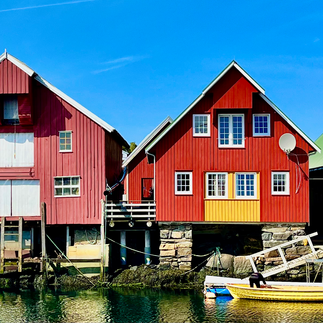Norway road trip: Oslo to the Atlantic
- Jan Dehn

- Jul 19, 2024
- 5 min read
Updated: 2 days ago

Spectacular views across Oppstrynsvatnet from Hjelle (Source: Own photo)
We took the scenic route from Oslo to Norway's Atlantic coast in mid-July 2024. The 813 km road trip started in the cultured modernity of Norway’s sophisticated capital and ended a week later in the peaceful fishing village of Bud on Norway's stunning southern coastline.
Between Oslo and Bud, we crossed the dramatic high mountain passes of Sognefjellet and Stryneflellet - with glaciers, icy lakes, and rugged peaks - before descending from Geiranger to sea-level at Vestness. From there, we took the ferry across to Molde and drove the last few kilometres to Bud.
Here are a few impressions from the journey.
Oslo is a good place to eat fresh salmon.

Restaurant 'The Salmon' on the Oslo waterfront serves fresh fish (Source: Own photo)
Moving on swiftly from the topic of food for the body to food for the soul, the Munch Museum is worth a visit. Like most Norwegians, Old Edvard loved his country and he had a good way of showing it. His collection is not just screams, it also has depictions of loneliness, sorrow, jealousy, loss, and general weirdness.
The Munch Museum is worth a visit in Oslo (Source: Own photos)
The Munch Museum sits within tall modern building next to the famous opera house, set back somewhat from a ferris wheel and a small beach, where people swim even though it is in the middle of the city. This is because Norwegians are very good at keeping the water clean. English, take note!

Swimming on the beach in front of the Munch Museum and the Opera House (Source: Own picture)
On Rådhusplassen, you find a fine statue of Tordenskjold, a daring navy captain, who made Vice Rear-Admiral at the tender age of 30, only to die the same year in duel over a trifling matter. Every Danish child knows Tordenskjold, because he features on the country's best-known brand of matchbox. They are not taught about Tordenskjold's exploits, however, so only older generations know that Tordenskjold built his reputation on raiding the evil Swedes. It is therefore only old people who fully appreciate the irony that the Tordenskjold brand of matches is now owned by a Swedish company.

Tordenskjold means "Thunder Shield" (Source: own photo)
From Oslo, the journey went North West. First stop was Geilo. It rained non-stop on the way, so I took no pictures. Besides, it was all trees, so I doubt I would have taken any pictures even if the weather had been clement.

The 813 km road trip from Oslo to Bud (Source: here)
The next day the rain had stopped. Clouds still hung heavy over the land, but as the day wore on the light got progressively better. So did the landscapes. The leg from Geilo to Flåm was beautiful as we entered the mountains with their characteristic steep Norwegian valleys. Beautiful girls with long blonde hair are known to frequent these parts, singing songs to lure men into the mountains from which they never re-appear.

The mountains begin to appear between Geilo and Flåm (Source: Own picture)
Flåm is a lovely little town. Below the town itself, you find what used to be a little commercial harbour. It is now a cruise ship terminal. During the day, the terminal fills up with people from all over the world, who sail kayaks, buy souvenirs, eat brown cheese, and take excursions, including return trips on the famous Flåm railway. The railway is ok, but you can see similar sights in a million other places in Norway. Just saying.

A cruise ship docked at Flåm (Source: Own photo)
The journey from Flåm to Lom - or Fossbergom as the area is also known - is truly spectacular. As you cross the imposing Sognefjellet, a high mountain pass, you are struck by the stark mountains, the many icy lakes, patches of snow from last winter, and the darkness of the low imposing clouds. This is a wild and grand place, with an icy wind. Few linger, but all remember.

Sognefjellet (Source: Own photo)
High mountain passes, such as Sognefjellet, are often closed in winter, when the snow piles high and the roads become impassable. You can see how high the snow gets by the sticks they plant along the roadside in places where snow is known to accumulate.

Tall sticks line the sides of the roads across the Sognefjellet to guide travellers in heavy snow conditions in winter (Source: Own photo)
As you drop down from Sognefjellet towards Lom, the landscape becomes gentler. Trees begin to appear and grassy meadows hug the lower slopes of the u-shaped valleys.

The road down from Sognefjellet towards Lom (Source: Own photo)
Lom itself is a pretty town set at the confluence of two rivers, one milky green, the other clear as a child's eye. An old wooden church with a pleasant smell of tar dominates the skyline and warns the good people of Lom against exercising independent spirit and free will.

Many Norwegians believe in super-natural things, such as the 'teachings' of the Christian bible (Source: Own photo)
The next leg of the trip took us from Lom to Hjelle. Like the day before, this was a truly epic journey, which crossed Strynefjellet, which, if anything, is even more impressive than Sognefjellet. It starts gently with fast-flowing rivers and pretty Norwegian houses with grass on the roof, but soon the valleys steepen until you find yourself travelling through a land of enormous saddlebacks with cold lakes, snow-clad mountain ranges disappearing into the clouds, and endlessness.
Travelling from Lom to Hjelle over Strynefjellet (Source: own photo)
After the brutality of Strynefjellet, Hjelle is perfect bliss. The picture at the top of this blog post is from Hjelle. Here is another taken from the lawn in front of the Hjelle Hotel. Hjelle Hotel is a beautiful white and green wooden structure on the banks of Oppstrynvatnet. The owners of the hotel are Lorenz and Emma Hjelle. Their family has run the hotel forever and they have given name to the village itself. You can use their rowing boats for free and the breakfast is rich and plentiful. And when Lorenz says the skies will clear, they clear! So there!

Idyl at Hjelle (Source: Own photo)
I recommend travelling the last leg from Hjelle to Bud via Geiranger. Like Flåm, Geiranger is a cruise ship port, but the road is far too beautiful to let that put you off. For example, while crossing the mountains towards Geiranger we came across this lake with the most perfect mirror image I have ever seen.

Is it a stone age arrow head or just a mountain reflected in an icy lake? (Source: Own photo)
The road down from Geiranger eventually takes you to the ferry port at Vestness, which sports a line of old fisherman's sheds alongside the ferry dock and the snowy peaks of Geiranger range in the background.

Vestness ferry port (Source: Own photo)
The electric ferry carries you quietly to Molde, a decent sized town, and from there you take a left and head out of town towards Bud. You are now on the Atlantic coast! When you get to Bud, park the car and hike along the "Kyststi" (the coastal path) to discover the super-pretty little fisherman's village. You will love the view, but also be reminded - by the Nazi guns emplacements on the rocks on the edge of town - that even as place as lovely and peaceful as Bud was once occupied by the Third Reich.
Bud (Source: Own photos)
The next leg of our Norwegian road trip will take us north along the famous Atlantic Road to Trondheim before we head out to Lofoten and from there set our sights at Tromsø and Svalbard.
Stay tuned!
The End




























Comments